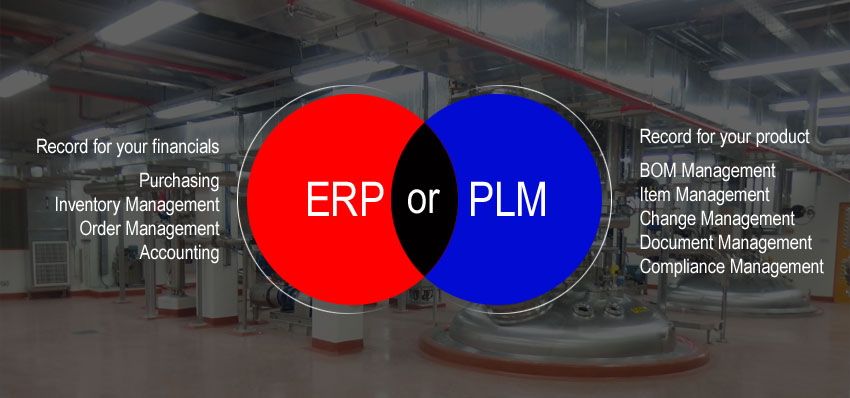ERP or PLM for Manufacturing success, what to Implement first?
Advancing technologies, followed by a swift digitization of various critical operations has transformed the manufacturing industry, drastically. In fact; with the competition getting steeper, manufacturers, today are quickly implementing and adopting various sophisticated tools such ERP and PLM to gain that cut above.
Several manufacturers are even going a step ahead by integrating ERP and PLM, in order to reap optimum benefits. However; sometimes, integration falls flat.
Now, the question, Does these two systems work together – if yes, how? Before, we delve deep into the ‘How, let us have a very brief idea about how ERP and PLM works in manufacturing industry.

ERP for Manufacturers:
- ERP systems enable organizations to plan for orders and profitability by offering manufacturers with a real-time status of their finances.
- With an ERP solution in place, manufacturers can conveniently keep a tab on orders and deliveries. The system gives them better insight of inventory, delivery lead times & production bottlenecks.
- Usually, companies involved with in-house manufacturing or in-house production of complex and customized products, go for a comprehensive ERP solution for effective information-flow within finance, sales and manufacturing departments.
However; companies outsourcing manufacturing operations, often utilize a smaller set of ERP tools that consists of modules like financial, accounts payable and receivable, inventory and procurement.
PLM for Manufacturers:
Product Lifecycle management or a PLM, offers control of product records across its development stages – right from conception to design and production.
- PLM system enables the company to manage product data like bill of materials, items, approved manufacturers lists and product files. Moreover, it allows one to monitor any changes in product information and further communicate any revisions to supply chain.
- Besides; with help of in-built automated change processes in the PLM, manufacturer can easily manage key product decisions like any last-minute modification change in real-time.
- PLM helps in conducting change requests and orders, further making it easier to consolidate, organize and track product data at centralized location, which otherwise gets dispersed throughout different departments.

How do ERP and PLM correspond?
Though, it supports distinct business requirements, ERP and PLM systems complement each other – perfectly.
Since, the core purpose of a PLM is to manage the development cycle of a product, while ERP system has to focus on resource management planning for production; it definitely makes more (financial) sense to use these tools in sequential order.
In fact, to organize and manage product data well, it should be initially stored within a PLM system.
Now, once the product design is developed to a point, and resources are required to be managed to create a design, the ERP system steps in. Upon integration with existing PLM system, it becomes more helpful. By integrating ERP with PLM, the most updated product data becomes available at any time. This further can be shared with other critical departments to ensure accurate financial planning.
Can you implement an ERP solution without PLM?
Running a business with only an ERP system may result in several and severe discrepancies in your manufacturing process. Companies with just an ERP system, often struggle to organize the most important part of their business – the product record.
In addition to this, resulting scrap and rework for the product in the office and on the shop floor, becomes costly. By implementing a PLM system in advance, an organization can confidently and accurately manage product information.
Since, ERP systems can only read BOM – Bill of Material for transactional purposes only, most of them does not properly change the functionality and are not even conducive to inter-departmental collaboration. Change history documentation is crucial to understand which revision has occurred and since when the change became effective.
Apparently; an organization that implements ERP system without a PLM system that compliments it, runs the risk of product changes mismanagement and inaccurate financial planning. Moreover, organizations utilizing lesser robust solutions like Excel or Spreadsheets to manage BOMs; also put the company at risk.
Challenges in Implementing ERP before PLM
Manufactures that got the ERP system first, and then opted for PLM implementation, often face numerous challenges that cripple the effective management of product record.
Let us see for an example, an engineering team without access to PLM system to centralize designs and monitor revisions, might end up submitting inaccurate product data to an ERP system. By managing product documentation and revisions in a PLM system and then syncing final product data to an ERP tool, manufacturers can avoid inaccurate ordering and avoid inefficient spending.
Synchronizing and building a data connection becomes cumbersome for a company, especially if a PLM is implemented after the ERP system is already up. Time, efforts and money it takes to decide which product data should be migrated from an existing ERP to PLM can be better spent elsewhere, especially in making production process, more effective.
By storing product data in a PLM and then migrates it to ERP, a manufacturer enjoys more cohesive and efficient manufacturing process with fewer oversights.
It is the order of tool implementation that matters the most
ERP and PLM systems have distinct functionalities. These functionalities when used together, gives manufacturers, the complete control over manufacturing processes.
However; these tools, are not interchangeable. An ERP system enables the company to manage transactional activities around building a product. On the other hand, a PLM system tells a story of the product at a particular point in time and history, and even the past records.
Establishing manufacturing process with an effective PLM before integrating it with a compatible ERP alleviates organizational inefficiencies and transition costs. Moreover, it even optimizes capabilities of each system throughout the organization.


 Chirag
Chirag








